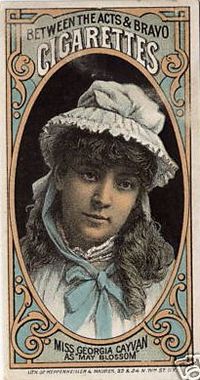
Georgia Cayvan
Encyclopedia

Early life
Georgia Cayvan was born at Bath, MaineBath, Maine
Bath is a city in Sagadahoc County, Maine, in the United States. As of the 2000 census, the city population was 9,266. It is the county seat of Sagadahoc County. Located on the Kennebec River, Bath is a port of entry with a good harbor. The city is popular with tourists, many drawn by its...
. She attended and graduated from the Boston School of Oratory
Emerson College
Emerson College is a private coeducational university located in Boston, Massachusetts. Founded in 1880 by Charles Wesley Emerson as a "school of oratory," Emerson is "the only comprehensive college or university in America dedicated exclusively to communication and the arts in a liberal arts...
. She initially earned a living as a professional fortune teller. She had insight into how to play out stage drama and brought her characters to fruition with her humor and expressive eyes.
Career

H.M.S. Pinafore
H.M.S. Pinafore; or, The Lass That Loved a Sailor is a comic opera in two acts, with music by Arthur Sullivan and a libretto by W. S. Gilbert. It opened at the Opera Comique in London, England, on 25 May 1878 and ran for 571 performances, which was the second-longest run of any musical...
with the Boston Ideal Opera Company. She was a member of the Union Square Company. She appeared in Hazel Kirke
Hazel Kirke
Hazel Kirke is a play in four acts written by American actor and dramatist Steele MacKaye. The play was written between 1878 and 1879 in the town of Dublin, New Hampshire. MacKaye meant it to be expressly for New York City's Madison Square Theatre, which MacKaye had recently renovated and...
at the Madison Square Theatre in New York City in 1881. She played the part of Dolly Dutton. In 1881 she played the heroine part in a road company in such comedies and dramas as The Professor (1881); The White Slave (1882); Siberia (1883); May Blossom (1884); The Wife (1887); The Charity Ball (1889); and Squire Kate (1892). She then appeared in "Oedipus Tyrannus" at the Boston Theater.
Cayvan also acted at Booth's Theater in New York City. She performed at the Fourteenth Street Theater in "The White Slave" and Laura in "The Romany Rye." She also played Marcelle in "A Parisian Romance" in the Union Square Company. Cayvan was successful in the leading part of David Belasco
David Belasco
David Belasco was an American theatrical producer, impresario, director and playwright.-Biography:Born in San Francisco, California, where his Sephardic Jewish parents had moved from London, England, during the Gold Rush, he began working in a San Francisco theatre doing a variety of routine jobs,...
’s "La Belle Russe." She was also a short time with Dion Boucicault
Dion Boucicault
Dionysius Lardner Boursiquot , commonly known as Dion Boucicault, was an Irish actor and playwright famed for his melodramas. By the later part of the 19th century, Boucicault had become known on both sides of the Atlantic as one of the most successful actor-playwright-managers then in the...
.
In 1893 Cayvan became the first person to wear a glass dress. The dress was too brittle to be practical however. It was exhibited at the World's Columbian Exposition
World's Columbian Exposition
The World's Columbian Exposition was a World's Fair held in Chicago in 1893 to celebrate the 400th anniversary of Christopher Columbus's arrival in the New World in 1492. Chicago bested New York City; Washington, D.C.; and St...
in The Chicago's World's Fair of 1893. An article in the New York Times of July 28, 1893, predicted that glass dresses would become a fashion "fad." It points out that the first dress was made for Cayvan for her performance in "American Abroad." It was made by the Libbey Glass Company. Author Amelia Ransome Neville in her book gave an account of seeing Cayvan wear the fiberglass
Fiberglass
Glass fiber is a material consisting of numerous extremely fine fibers of glass.Glassmakers throughout history have experimented with glass fibers, but mass manufacture of glass fiber was only made possible with the invention of finer machine tooling...
dress made by Edward Drummond Libbey
Edward Drummond Libbey
Edward Drummond Libbey is the father of the glass industry in Toledo, Ohio, where he opened the Libbey Glass Company in 1888.-Biography:Libbey was born in Chelsea, Massachusetts, USA...
. She points out that Cayvan wore it in The Charity Ball.
In 1886 Cayvan contracted with Daniel Frohman
Daniel Frohman
Daniel Frohman was a Jewish American theatrical producer and manager, and an early film producer.Frohman was born in Sandusky, Ohio...
, becoming the star of the Lyceum Theater
Lyceum Theatre (New York, 1885-1902)
The Lyceum Theatre operated on Manhattan’s Fourth Avenue between 23rd and 24th Streets, from 1885 to 1902, when it was torn down to make way for the Metropolitan Life Insurance Company Tower and replaced by the Lyceum Theatre on 45th Street...
in New York. Cayvan toured with her own company (which included Lionel Barrymore
Lionel Barrymore
Lionel Barrymore was an American actor of stage, screen and radio. He won an Academy Award for Best Actor for his performance in A Free Soul...
) starting in 1896. She was involved in a difficult divorce case in 1896 as being the other woman. She was, however, totally exonerated after defending herself. Cayvan received much support from several women's groups.

